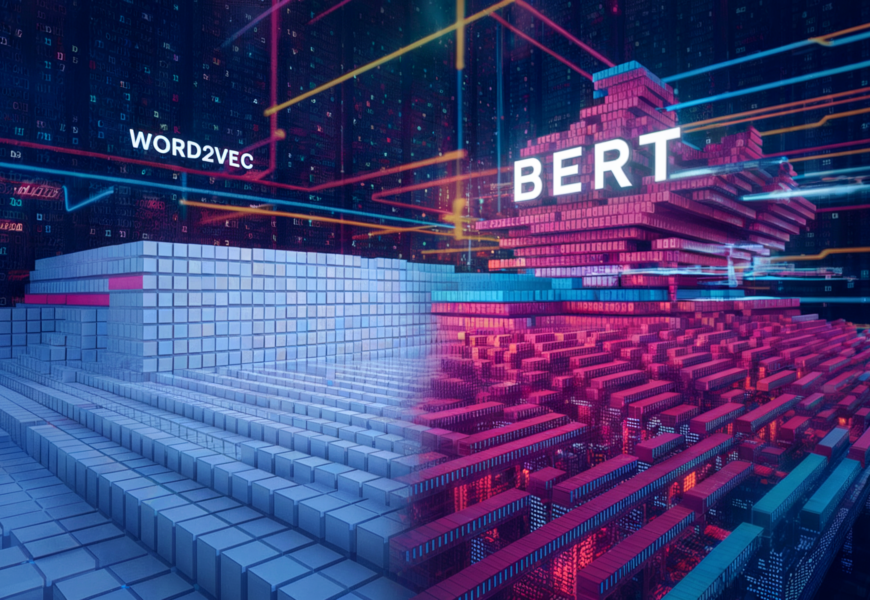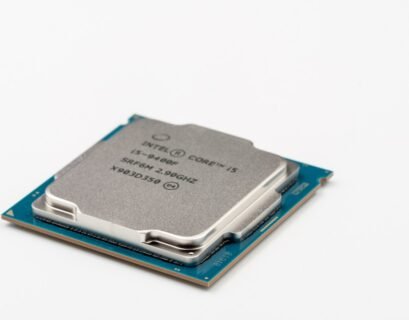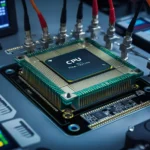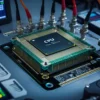In the dynamic field of Natural Language Processing (NLP), word embeddings NLP has become fundamental to how machines comprehend and process human language. Since the groundbreaking introduction of Word2Vec in 2013 to the revolutionary BERT model in 2019, the journey of word embeddings has been remarkable. This article delves deep into the world of word embeddings, exploring their evolution, comparing key models, and uncovering their practical applications in today’s AI-driven world.
What Are Word Embeddings?
Before we embark on our journey through the evolution of word embeddings, let’s start with the basics. What exactly are word embeddings, and why are they so crucial in the field of NLP?
Word embeddings are vector representations of words in a continuous vector space. In simpler terms, they’re a way to represent words as numbers that computers can understand and process. These numerical representations capture semantic relationships between words, allowing machines to grasp the meaning and context of language in a way that’s similar to human understanding.
The importance of word embeddings in NLP cannot be overstated. They serve as the foundation for numerous language understanding tasks, including:
- Text classification
- Sentiment analysis
- Named entity recognition
- Machine translation
- Question answering systems
By converting words into dense vector representations, word embeddings enable machines to perform complex language tasks with remarkable accuracy and efficiency.
The history of word embeddings dates back to the early 2000s, with techniques like Latent Semantic Analysis (LSA) and neural network-based language models. However, it wasn’t until the introduction of Word2Vec in 2013 that word embeddings truly revolutionized the field of NLP.
Word2Vec: The Pioneer of Modern Word Embeddings
In 2013, Google researchers Tomas Mikolov, Kai Chen, Greg Corrado, and Jeffrey Dean introduced Word2Vec, a groundbreaking approach to creating word embeddings. This model marked a significant leap forward in how machines could understand and represent words in vector space.Word2Vec is based on a shallow neural network architecture, which means it uses a simple neural network with just one hidden layer. This architecture allows the model to efficiently learn word representations from large amounts of text data.
The key feature of Word2Vec is its ability to create context-independent word representations. This means that each word is assigned a fixed vector representation, regardless of the context in which it appears. While this approach has its limitations (which we’ll discuss later), it was a game-changer at the time, offering several significant advantages:
- Efficiency: Word2Vec’s shallow architecture allows it to process large volumes of text data quickly, making it practical for real-world applications.
- Semantic relationships: The model captures semantic relationships between words, allowing for operations like word analogies (e.g., “king” – “man” + “woman” ≈ “queen”).
- Dimensionality reduction: Word2Vec creates dense vector representations, typically with 100-300 dimensions, which is far more compact than traditional one-hot encoding methods.
- Transferability: Pre-trained Word2Vec models can be used across different NLP tasks, saving time and computational resources.
However, Word2Vec also has its limitations:
- Context insensitivity: The fixed representations don’t account for the different meanings a word might have in various contexts.
- Out-of-vocabulary words: Word2Vec struggles with words it hasn’t seen during training, which can be problematic for domain-specific applications.
- Lack of subword information: The model treats each word as an atomic unit, missing out on potentially useful information contained in word parts or morphemes.
Despite these limitations, Word2Vec paved the way for more advanced word embedding techniques and remains a valuable tool in many NLP applications today.
The Evolution: From Static to Dynamic Embeddings
As researchers and practitioners began to push the boundaries of what was possible with Word2Vec, it became clear that the next frontier in word embeddings lay in addressing the context insensitivity problem. This realization led to a transition from static, fixed representations to more dynamic, context-aware models.
One of the key intermediate steps in this evolution was the introduction of ELMo (Embeddings from Language Models) in 2018 by researchers at the Allen Institute for Artificial Intelligence. ELMo represented a significant leap forward in several ways:
- Contextual representations: Unlike Word2Vec, ELMo generates different representations for the same word based on its context, capturing the word’s meaning more accurately.
- Deep bidirectional language model: ELMo uses a deep neural network architecture that processes text in both forward and backward directions, allowing it to capture more nuanced language understanding.
- Character-level inputs: By operating at the character level, ELMo can handle out-of-vocabulary words and capture subword information.
The introduction of ELMo and similar models highlighted the need for more nuanced language understanding in NLP systems. These advancements set the stage for the next revolutionary step in word embeddings: BERT.
BERT: Revolutionizing Contextual Word Embeddings
In 2019, Google researchers Jacob Devlin, Ming-Wei Chang, Kenton Lee, and Kristina Toutanova introduced BERT (Bidirectional Encoder Representations from Transformers), a model that would once again redefine the landscape of NLP.BERT represents a quantum leap in the field of word embeddings and language understanding. Its key features include:
- Dynamic, context-aware word representations: BERT generates different embeddings for the same word based on its surrounding context, capturing nuanced meanings and uses of words.
- Bidirectional context: Unlike previous models that processed text in a left-to-right or right-to-left manner, BERT considers the entire context of a word (both left and right) simultaneously.
- Transformer architecture: BERT leverages the powerful Transformer architecture, which uses self-attention mechanisms to capture long-range dependencies in text.
- Pre-training and fine-tuning: BERT is pre-trained on a massive amount of unlabeled text data and can be fine-tuned for specific NLP tasks with minimal additional training.
BERT overcomes many of Word2Vec’s limitations:
- Context sensitivity: BERT’s dynamic representations capture the different meanings of words in various contexts, addressing the polysemy problem.
- Handling of rare words: Through its use of subword tokenization, BERT can better handle rare or out-of-vocabulary words.
- Deep language understanding: BERT’s deep architecture and bidirectional nature allow it to capture more complex language patterns and relationships.
The impact of BERT on the field of NLP has been profound. It has set new state-of-the-art benchmarks on a wide range of NLP tasks and has spawned numerous variations and improvements, such as RoBERTa, ALBERT, and T5.
Word2Vec vs. BERT: A Comprehensive Comparison
Now that we’ve explored both Word2Vec and BERT, let’s dive into a detailed comparison of these two influential models:
- Architectural differences:
- Word2Vec: Uses a shallow neural network with one hidden layer.
- BERT: Employs a deep Transformer architecture with multiple layers of self-attention.
- Context handling:
- Word2Vec: Generates fixed, context-independent representations for each word.
- BERT: Creates dynamic, context-aware representations that change based on the word’s surroundings.
- Training approach:
- Word2Vec: Typically trained on domain-specific corpora to learn word co-occurrences.
- BERT: Pre-trained on massive, diverse text datasets using masked language modeling and next sentence prediction tasks.
- Computational requirements:
- Word2Vec: Relatively lightweight, can be trained on standard hardware.
- BERT: Requires significant computational resources for training and inference, often necessitating GPU acceleration.
- Handling of out-of-vocabulary words:
- Word2Vec: Struggles with words not seen during training.
- BERT: Uses subword tokenization to handle rare or unseen words more effectively.
- Capturing word relationships:
- Word2Vec: Excels at capturing simple semantic relationships and word analogies.
- BERT: Captures more complex, context-dependent relationships between words and phrases.
- Performance in various NLP tasks:
- Word2Vec: Still effective for many tasks, especially when computational resources are limited.
- BERT: Generally outperforms Word2Vec across a wide range of NLP tasks, particularly those requiring deep language understanding.
While BERT has clear advantages in many areas, it’s important to note that Word2Vec still has its place in the NLP ecosystem, particularly in scenarios where computational efficiency is a priority or when dealing with specific domain languages where pre-trained BERT models might not be available.
Practical Applications of Word Embeddings
The evolution from Word2Vec to BERT has opened up new possibilities in various NLP applications. Let’s explore some practical use cases:
- Text Classification:
- Word2Vec: Useful for simple classification tasks, especially when combined with traditional machine learning algorithms like SVM or Random Forests.
- BERT: Excels in complex classification tasks, particularly when fine-grained understanding of context is required.
- Sentiment Analysis:
- Word2Vec: Can capture general sentiment associations of words.
- BERT: Better at understanding nuanced sentiment expressions and detecting sarcasm or irony.
- Named Entity Recognition (NER):
- Word2Vec: Effective for identifying common entities in specific domains.
- BERT: More accurate in identifying and classifying entities, especially in ambiguous contexts.
- Machine Translation:
- Word2Vec: Used in earlier neural machine translation systems.
- BERT: Powers state-of-the-art translation systems, capturing nuanced meanings across languages.
- Question Answering:
- Word2Vec: Limited in its ability to understand complex questions and extract relevant information.
- BERT: Excels in comprehending questions and identifying relevant information from context, powering advanced QA systems.
- Search Engines:
- Word2Vec: Used for query expansion and basic semantic search.
- BERT: Enables more sophisticated semantic search, understanding user intent, and ranking results based on relevance.
- Recommendation Systems:
- Word2Vec: Effective for content-based recommendations.
- BERT: Allows for more nuanced understanding of user preferences and item descriptions, leading to improved recommendations.
These applications demonstrate the significant impact that the evolution of word embeddings has had on various aspects of NLP and AI-driven systems.
Choosing the Right Word Embedding Technique
While BERT has set new standards in NLP performance, it’s not always the best choice for every situation. Here are some factors to consider when choosing between Word2Vec and BERT:
- Task complexity:
- For simple tasks like keyword matching or basic text classification, Word2Vec might be sufficient.
- For complex tasks requiring deep language understanding, BERT is often the better choice.
- Computational resources:
- If you’re working with limited computational power or need real-time processing, Word2Vec might be more suitable.
- For applications where accuracy is paramount and computational resources are available, BERT is preferable.
- Data availability:
- Word2Vec can be effectively trained on smaller, domain-specific datasets.
- BERT typically requires large amounts of data for fine-tuning, though pre-trained models are available for many languages and domains.
- Interpretability:
- Word2Vec embeddings are often more interpretable and easier to visualize.
- BERT’s complex, context-dependent representations can be more challenging to interpret directly.
- Deployment environment:
- For edge devices or environments with limited resources, Word2Vec might be more practical.
- For cloud-based applications or scenarios where model size isn’t a constraint, BERT can provide superior performance.
- Domain specificity:
- If you’re working in a highly specialized domain with unique terminology, training a custom Word2Vec model might be more effective than fine-tuning a general-purpose BERT model.
- Multilingual requirements:
- For multilingual applications, BERT and its variants (like mBERT) often provide better cross-lingual performance.
Remember, the choice between Word2Vec and BERT isn’t always binary. In some cases, a hybrid approach using both models or even more recent developments like GPT-3 or T5 might be the optimal solution.
Conclusion
As we’ve explored the journey from Word2Vec to BERT, it’s clear that the field of word embeddings has undergone a remarkable transformation. We’ve moved from static, context-independent representations to dynamic, context-aware models that capture the nuances of language with unprecedented accuracy.
Word2Vec, with its innovative approach to vector representations, laid the foundation for modern NLP. It showed us that words could be represented in a way that captures semantic relationships, opening up new possibilities in language understanding.
BERT, building on the shoulders of giants, pushed the boundaries even further. By introducing context-aware embeddings and leveraging the power of deep, bidirectional language models, BERT has revolutionized how machines understand and process human language.
As we look to the future, one thing is certain: the quest for more accurate and nuanced language understanding will continue to drive innovation in this exciting field. We’re already seeing new models and techniques emerging, such as GPT-3, T5, and ELECTRA, each pushing the boundaries of what’s possible in NLP.
For developers, researchers, and anyone working with language technologies, staying abreast of these advancements is crucial. The choice between Word2Vec, BERT, or newer models will depend on the specific requirements of each project, balancing factors like accuracy, computational efficiency, and domain specificity.
As AI continues to permeate every aspect of our digital lives, from search engines to virtual assistants, the importance of sophisticated language understanding cannot be overstated. The evolution of word embeddings from Word2Vec to BERT and beyond is not just a technical achievement – it’s a step towards machines that can truly understand and interact with human language in all its complexity and nuance.
Whether you’re developing the next generation of language technologies or simply curious about the AI that powers our digital world, the story of word embeddings is a testament to the rapid pace of innovation in AI and NLP. As we continue to push the boundaries of what’s possible, who knows what the next breakthrough in language understanding might bring? One thing’s for sure – it’s an exciting time to be involved in the world of NLP!


















